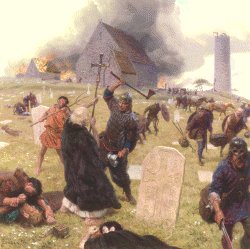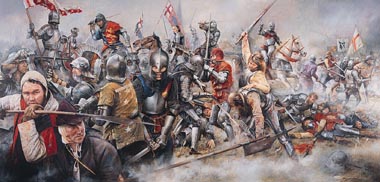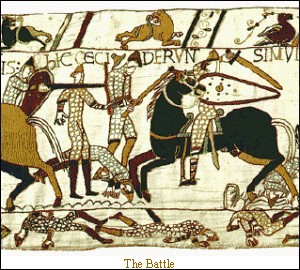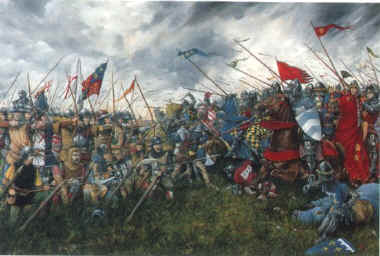 Norsemen Sack Monastry.
Norsemen Sack Monastry. Battle of Hastings - The Death of Harold.
Battle of Hastings - The Death of Harold.To Me! is a computer moderated wargaming system for the Dark Age and Medieval Era covering the period from the fall of Rome until the early Renaissance. It caters for a wide variety of major armies, including Crusaders, Saracens, Teutonic Order, Normans, Saxons and Danes, to name just a few. You could probably use armies from other periods and locations as the characteristics used to describe units and generals are quite comperhensive, its just that the makers could not guarantee the combat responses as being historically accurate - although they would probably be close at least. This is particularly so because stereotypes are not used and so you are not obliged to use the makers vesion of national types such as Normans or of particular generals such as William the Conqueror. The basic building blocks such as morale, training level, tactical styles, orders and officer personalities etc are provided with suggested guidelines for their use, but you are free to express your own view of history.
Although fully compatible with any of the major games rules sets, To Me! has tried to go further by giving extra features such as allowing for the effect of generals, orders and the chain of command. No rebasing is required and it is equally suitable for 5, 15 or 25 mm figures. In fact you don't need to have figures, coloured blocks of cardboard are adequate to represent individual units and their officers.
One major difference between To Me! and other current miniatures rule sets is the existence of Yeoman, Horse Archer and other tactical styles as well as the normal Regular and Irregular styles. This emphasis has the important effect of reducing what some would see as the over-emphasis on weaponry.
We are always looking for ideas from players as to what to include or change. It is a "for wargamers by wargamers approach" with the system being sold at minimum cost to encourage computer based gaming as a generally acceptable approach. New versions are being developed on an ongoing basis.
The new Version allows you the ultimate in army, battle and campaign size. There is no limit on the number of units or officers in an army! Battles can have any number of sides and any number of armies on each side! This accomodates even the largest club campaign game. To Me! also provides the enhanced Windows usability that allows greater ease of use and faster play without the PC intruding into the players awareness.
Back to Top
 The Battle of Barnet.
The Battle of Barnet.Barbarians are particularly ferocious when fresh and respond to sacred standards with fanaticism, until such a standard is lost. - then they can buckle rapidly. Fatigue and morale are the major determinants of capacity to fight and barbarians need large war bands to absorb the punsihment. Regulars, Yeoman and Horse Archers tend to fatigue less rapidly than barbarians but are less impetuous.
The Horse Archer tactical style allows the player to differentiate between ordinary cavalry and the true horse archer. The latter is assumed to have some remounts available and so does not succum to fatigue at the same rate as normal cavalry. This allows them to employ traditional tactics such as engaging in a protracted firefight while maneauvering on horseback. Naturally this type is meant to apply more in the Byzantine arena when horse archer tactics were more developed.
Overall this shift in emphasis towards tactical styles rather than weapon types means there is no pouring over army lists to extract the last point advantage, as with some current rules. Special weapons are reduced to their historical effectiveness and lack the "nuclear" effectiveness that once made them all important in some rules sets. The points are mostly awarded according to numbers of troops and their tactical style. However weapon types do retain much of their familiar historical effectiveness. For example, steady Pikes and Long Thrusting Spears are very effective against cavalry, who will be reluctant to charge troops thus armed. Consequently, the game does not represent a radical relearning process and the gamer can play easily from the start. Most of the rules are safely locked away in the computer and you are only confronted with a one page rule list. The documentation, which discusses tactical concepts, does however run to about 30 pages and gives a good background to the general ideas behind To Me! - this means there are no surprises lurking ready to disappoint you.
 Battle of Hastings.
Battle of Hastings.The Battle module has three phases.
1. Deployment. At the start of each round use the Deployment Phase to perform all the actions that are preliminary to combat, such as formation changes, sending Orders, testing for Charges and testing for other events such as a unit's success at scouting or movement through difficult terrain. You should think carefully about your tactics before you issue directions. For example, if a command has been on the defensive (with Hold Orders) and the enemy attack is faltering, you may decide to attack soon. Think ahead and send an Attack order some rounds in advance. Once it arrives and you want to encourage the men to charge, then send their commander to join the key unit BEFORE you test for the charge. Sending him afterwards will be too late. Remember to allow some margin for delays and errors such as a misinterpretation of Orders. This is part of the "fog of battle" built into To Me! You will find that it is quite a challenge to control a battle without modern aids such as direct radio contact. It gives the sensation of how it must have been and you may feel more sympathy for generals of those times after the experience.
A unit that has been involved in a test to charge will not be given a result immediately. This will be given once you move to the next phase (Firing). The reason for the delayed notification is that the unit may be involved in more than one charge and these may be against different types of targets. Consequently the total situation needs to be evaluated before the decision can be made on whether the unit charges, stands, runs etc. The total situation is only available once the Deployment phase is concluded.
After players have finished Deploying, choose the next phase, which is Firing.
 The Battle of Agincourt.
The Battle of Agincourt.2. Firing. To fire, the player chooses the unit from the drop down list, chooses the target and adjust the target conditions (ie range, cover type etc). Then clicks on the Fire button at the bottom of the form. The losses resulting will be displayed immediately. If a unit is firing on more than one target then the player can split the fire according to the number of elements remaining in the unit.
Firing is simultaneous in this period and the effects of firing are not applied until the next bound.
3. Melee. At the start of melee, those units that have successfully tested to charge will be tested for charging home on the target in the light of the effect of any firing on them. Some may have taken unacceptable losses and may recoil without contacting their opponent. When fighting more than one target you may split the combat according to the number of elements that are available to fight.
Units that have been involved in a melee will only be given a broad interim outcome at the time of combat. The final outcome will be given once you cycle back to the first phase (Deployment). The reason for the delayed notification is that the unit may be involved in more than one melee and these may be against different types of targets. Consequently the unit may win against one but lose against another. Therefore the total situation is evaluated for you before the decision is made on whether the unit wins, loses, stands, runs etc. Then the position of the unit on the tabletop would be changed according to the outcome shown by To Me!
Grand Tactical module is included at no extra cost.
The Grand Tactical module allows you to play against one or more opponents in the aproach moves that lead to a battle. The players deploy their commands in a landscape with terrain generated by the computer and then move towards a tabletop area marked in the centre of the table. During this Grand Tactical movement, commander ability, encounters with the enemy, difficult terrain and the excessive crowding of friendly commands can all contribute to delays and mishaps. When enough commands have entered the tabletop area the system declares the battle ready to start and exports the armies ready for battle. Commands that have not reached the tabletop area are set to flank march and appear later during the battle (you hope!). A Tactical Map of the battlefield with computer generated terrain and initial starting point for each command is provided for you to print and use as an aid to initial deployment. You now import the armies into the battle module and you are ready to fight the battle!
Solo and Campaign modules are also included at no extra cost.
 Norsemen Sack Monastry.
Norsemen Sack Monastry.
The Solo module allows you to play against the system using a number of scenarios. Responses considered typical of an historical general are provided by the Solo module and are displayed for the gamer to act upon. The amount of activity needed at the screen is reduced as the Solo system handles all formation and order changes within the PC. The player does not need to perform these as well as those needed for his own side. Player intervention in the Solo side's activities is allowed however, so that inappropriate responses can be corrected.
The Campaign module allows map maneauver taking into account terrain and logistics effects on the armies. To increase ease of setup and to enhance the attractiveness of campaign games a number of colour maps with terrain displayed are automatically available for selection in the computer. The computer "sees" the map as a grid, with each sector having certain characteristics such as the arrability of the land, difficulty of the terrain etc.
The role of Quartermaster has been taken over by the system to reduce the onorous administrative load usually associated with campaigns. Bases can be created and resupply is allowed for. Losses through starvation, disease and straggling are also determined by the system. Sieges can be setup and the associated losses and the outcome are controlled by the system.
 William the Conqueror Sails for England.
William the Conqueror Sails for England.Naval rules have now been integrated with the existing land based rules. This provides the player with even more options than before. The player can either play the same land based games as before, or play a conventional naval game, or play a combined arms action in which both naval and land forces are present and can fire on each other as well as ram and board.
Each bound the system determines and displays the wind direction and strength, as well as recalculating the maximum turn and speed of each vessel based on a number of factors such as the training level, morale and fatigue of the crew and the state of the ship. A chart is provided to allow the player to calculate the ship's speed based on its angle to the wind. The damage inflicted by enemy fire includes flooding and fires caused. The effectiveness of damage control in stopping these problems is reassessed each turn by the system. After receiving heavy damage a captain may surrender and a ship and be destroyed by fire. Close Actions such as Ramming and Boarding are also supported.
A range of naval weapons are provided to allow the vessel to be armed historically. These include Catapults, Balista and Ramming Prows. A wide range of ship types is also provided,
To add realism, several kinds of fortifications have been added to the already extensive range of troop types. These can be armed with artillery and are assumed to have their own garrison. These forts can act as fixed strong points that can fire, be fired upon and can resist or be overrun by storming parties. The forts range from hastily fortified positions to heavy stone forts. A cluster of these strong points can be used to represent the aggregation of strong points (bastions) that compose any major fortification.